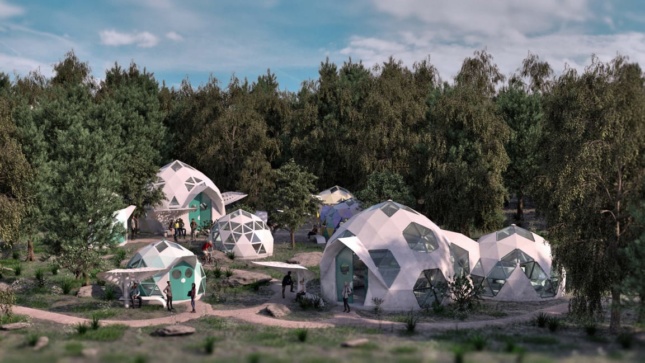Geoship, a startup with a plan to revolutionize single-family housing, has caught the attention of Zappos via Tyler Williams, director of brand experience at the shoe retailer’s Las Vegas headquarters. The two companies are now working together to make geodesic dome structures the homes of the future, addressing a variety of mounting social and environmental concerns in what they’re calling affordable, regenerative architecture.
Geoship’s dome structures are made of bioceramic, a self-adhesive material made largely out of phosphate, which can be recycled from wastewater. The material is touted as being “nearly indestructible,” making it suitable for a world hurtling towards a climate crisis—the homes can withstand a heat of up to 2,700 degrees Fahrenheit without burning, resist insects and mold, and can weather tremors and storm surge from earthquakes and hurricanes alike. All of this? “Essentially, it’s like Legos going together,” Geoship founder Morgan Bierschenk told Fast Company. The startup claims their domes cost 40 percent less to build than traditional existing construction methods.
The geodesic domed shape, similar to that of a soccer ball, is made up of faceted triangles and pentagons welded together via the bioceramic’s self-gluing properties. The form and its translucent, light-filled nature were popularized by great 20th-century architect and engineer Buckminster Fuller, who used the form and technology to build structures like his pavilion at Expo 67 in Montreal or the Dymaxion House. The shape is inherently strong and structurally sound and this is further enhanced by Geoship’s combination of the classic form with a new material.
Zappos jumped on the fundraising wagon with Geoship when Williams recognized the domes’ potential to address homelessness around its Las Vegas headquarters. The idea of a collective of the domes, made available for free to the homeless adjacent to Zappos’s office, was a shared vision of both Bierschenk and Williams. The solution combines low-cost housing with extreme environmental sensitivity; Geoship claims that there is even a possibility that the domes could become carbon negative, as bioceramic has the ability to absorb amounts of carbon dioxide from the atmosphere.
Geoship also argues some more theoretical points—the domes are supposedly said to align with Vastu Shastra, a traditional Indian theory of architecture. The goal, though, is to appeal to a mass audience and modernize home building: “We started to question why we’re still pounding nails in wood, like people were doing 100 years ago,” said Bierschenk.
It may take some time before the unlikely partnership bears dome-shaped fruit; Bierschenk estimates it will be at least two years before the structures begin production. Whether we can “envision a new future for Earth” as Geoship encourages us to do remains to be seen—as well as the company’s claims that the interiors of their domes harmonize the electromagnetic environment with biological systems—but at least the homeless population in Las Vegas may be getting a new form of housing.
